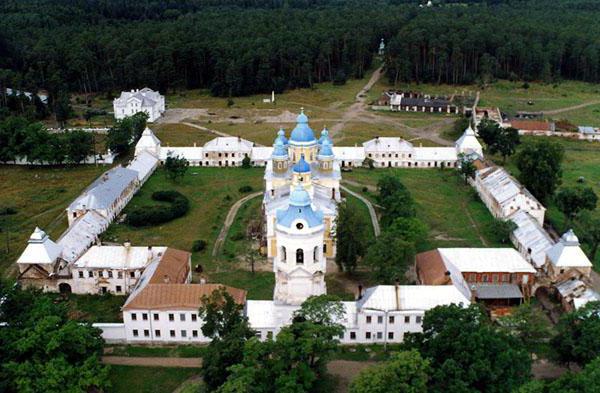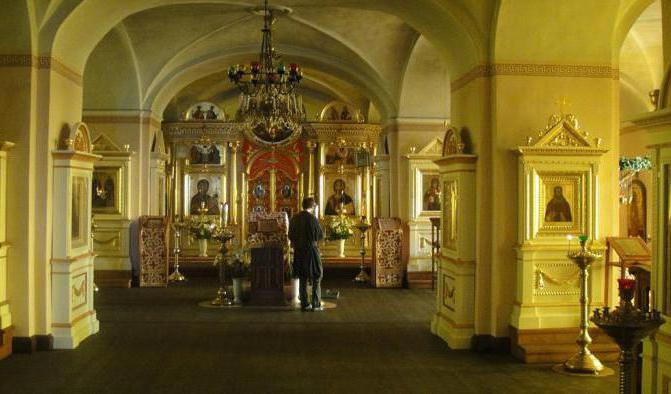Long before the appearance of the monastery on the island of Konevets, the Ladoga and Karelian lands were inhabited by Finno-Ugric tribes. Koreles lived to the north and on Karelian land, in the west, next to them, lived East Slavic tribes: Krivichi and Ilmen Slavs. To the east of Lake Ladoga - Chud, on the Neva River and on the coast of the Baltic Sea - Izhora and Veps. Until the baptism of Rus, these tribes were pagan. Across the land, they set up many pagan temples, where they worshiped the gods Veles and Perun. In Russia with the adoption of Christianity in 988 during the time of Prince Vladimir, a new faith spread far to the northern lands. Konevsky Nativity-Theotokos Monastery on Lake Ladoga was created in 1393 by the Monk Arseniy Konevsky. His sole purpose was the conversion of idolaters to the Christian faith.
Location
Konevsky Nativity-Theotokos Monastery is located on the island of Konevets in the west of Lake Ladoga, in the Leningrad Region. This island is located five kilometers from the mainland. The Konevets Strait separates them from each other. The area of the island is about 8.5 square kilometers. Sometimes it is perceived as a double of the Valaam monastery, which is located on the island of Valaam in Lake Ladoga.
Konevsky Nativity-Theotokos Monastery: History
In the Middle Ages, pagan temples of various Finnish tribes were located on Konevets. The pagans worshiped the gods they invented for themselves. One of their most revered was a huge boulder (over 750 tons), reminiscent of the shape of a horse’s skull. This stone was called "Horse-Stone", from which the island was named.
Middle Ages
Arseny Konevsky (a native of Nizhny Novgorod) founded a monastery in 1393 in order to convert polytheists to the Christian faith. Not much is known about Arseny himself. There is information that at the age of 20 he was tonsured a monk and lived in the Lisogorsky monastery of the Novgorod region for about 10 years. After that, he went to Athos and spent three years there, receiving as an blessing the icon of the Mother of God, which later became known as Konevskaya. Wanting to live in more privacy, Arseny Konevsky received a blessing from the Novgorod Archbishop John II and chose the island of Konevets for living. St. Arseny erected a cross and built a cell in the depths of Konevets, on a small hill. Later, when he had students, he moved his monastery closer to the banks of the Ladoga River.

According to the Novgorod annals , a monastery was built in 1398. We can assume that the Konevsky Nativity of the Theotokos Monastery was the first stone building on the Karelian Isthmus. After the past flood (1421), it was decided to raise the monastery to a height, where it is now. Saint Arseny in 1421 began the construction of the Cathedral of the Nativity of the Virgin. It was the main church of the Konevsky Nativity of the Virgin Monastery. Its main shrine is the miraculous Konevskaya icon of the Mother of God. She was brought from Athos by Arseny and was a Christ playing with a pigeon chick, which reflects spiritual purity.
During the Russian-Swedish war, which lasted from 1614 to 1617, the island was captured by the Swedes, and the monks were expelled to Nizhny Novgorod, where they were placed in the Derevyanitsky monastery. During the Great Northern War, Russia was able to regain these lands. In 1718, the rector of the Derevyanitsky monastery received permission from Peter I to restore the monastery on the island. Revived in 1760, it was officially recognized as independent.
XIX century
The best time of the Konevsky Nativity of the Virgin Monastery fell on the XIX century - while the fame of it reached the capital. In 1858, Alexander II visited him with his family and other high-ranking guests. Due to their popularity, the monks were able to begin construction of new facilities. Were built: a two-story cathedral with a bell tower (construction began in 1800 and lasted 9 years) and a high three-story bell tower (1810-1812).
The cloister was completely erected from stone. Three types of monastic life have formed:
- Hermit
- sociable;
- skitskaya.
The Konevsky monastery and the Kazan monastery were created on the island.
XX century
In 1917, after the Great October Revolution, the Konevsky Nativity of the Theotokos Monastery ended up in Finland. Accordingly, it fell under the jurisdiction of the Finnish Orthodox Church. On the island of Konevets, the Finns erected defenses. During the Russo-Finnish War (1939-1940) and the Great Patriotic Wall, the monastery walls were destroyed. After the end of the Russo-Finnish war, 11% of the Finnish lands began to belong to the USSR. In March 1940, the monks went to Finland (taking some valuables from the church with them). In Finland, the New Valaam Monastery was founded. During the war years 1941-1945, when the Finnish military occupied the island, a small group of monks returned to the island. In 1956, only 9 people remained from the group. They decided: to unite the two monasteries of Valaam and Konevsky. The monks, taking with them the Konevsky Icon of the Mother of God, went to the estate of Papinniemi, which belonged to the New Balaam.
On the island of Konevets immediately after the end of the Second World War, the naval part of the Soviet Union was located. The military destroyed the monastery cemetery and chapel, it was destroyed with a bulldozer.
In 1991, the Konevsky Nativity-Mother of God Monastery was transferred to the Russian Orthodox Church. After that, his rebirth began.
In the fall of 1991, the relics of Ave Arseniy Konevsky were brought to the monastery, hidden from the Swedes who captured these lands in 1577. The relics were stored under the floor of one of the temples, they are the main shrine of the Konevsky Nativity of the Virgin Monastery. Another shrine - the Miraculous Konevskaya Icon of the Mother of God is still in Finland.
In 1994, the first monastic tonsure was performed at the monastery. Today, many pilgrims and tourists come here. In order to get to the island you need a personal blessing from the rector of the Konevsky Nativity of the Virgin Monastery or the permission of the Pilgrimage Service.
Acting cathedrals, temples, chapels, hermitages
Currently, the monastery has several temples, chapels and hermitages. Let us dwell in more detail on some of them.
Cathedral of the Nativity of the Blessed Virgin Mary
The cathedral is considered the oldest building. The place for him in 1421 was also chosen by the Monk Arseny himself. After a severe flood, it was decided to move the monastery and monastery away from the shore of Lake Ladoga. Later, several more times, the monastery was routed and rebuilt. The first rebuilt cathedral was wooden; it was built by Ave Arseny. It was burned in 1574 when the Swedes occupied this land. After the monks returned to the island in the 16th century, they rebuilt the new cathedral from stone already. In 1610, the Swedes again seized these lands and completely dismantled the cathedral building. During the Northern War, Russia regained these lands. In 1766, the cathedral was erected again, but by the end of the XVIII century it came into disrepair. And in the spring of 1800, the construction of the temple began.

In just a year, the first floor was rebuilt and overlap was made. But there was not enough money on the second floor. In 1802, Alexander I made a donation, thanks to this it became possible to complete the second floor and finish on the first. To date, the restoration of the lower church has been held, services are held here. The second floor was badly damaged during the years of Soviet power; it needs major repairs. There are such shrines in the Cathedral: a list from the miraculous Kanev icon of the Divine Matter and the ark with the relics of the Monk Arseny.
Chapel of the Apparition of the Mother of God
The chapel was built on the Holy Mountain after the Mother of God appeared to the old man Joachim. The construction was put on the very edge of the mountain, in the place where once there was a worship cross, established by Arseniy himself. The chapel is considered the oldest building on Konevets. In the XIX century it was rebuilt. During the Soviet era, the chapel was lowered from the mountain to the pier and was used as a checkpoint. When Konevets was returned to the monastery, the chapel was raised back to the Holy Mountain. The interior was restored again.
Church in the name of St. Nicholas the Wonderworker (1815)
This stone-built temple was built on the site of a wooden church that once stood here. The previous wooden church was restored after the Northern War with the Swedes in 1718 and was illuminated in November 1719. In 1762 it was updated and called a cemetery - in its porch at that time a cemetery was built. From 1812 to 1815 the wooden building was replaced by a stone one. The church contained a four-tier iconostasis, the image of Ave Arseny, images from the life of St. Nicholas the Wonderworker and Arseny, rare ancient icons. In the 40s, with the advent of the military, this all disappeared. Currently, there is only one fence left from the monastery cemetery.
Konevsky Nativity-Theotokos Monastery: Rectors
Among the rectors of this monastery, in addition to Arseniy Konevsky, it is worth highlighting the spiritual writer and archimandrite Hilarion (in the world of Ivan Kirillov), who transformed the monastery, giving him a new charter.
The abbot of Israel Andreev, who developed cattle breeding and horse breeding, also played a special role in the life of the monastery. It was Israel that substantially replenished the fund of the monastery library.